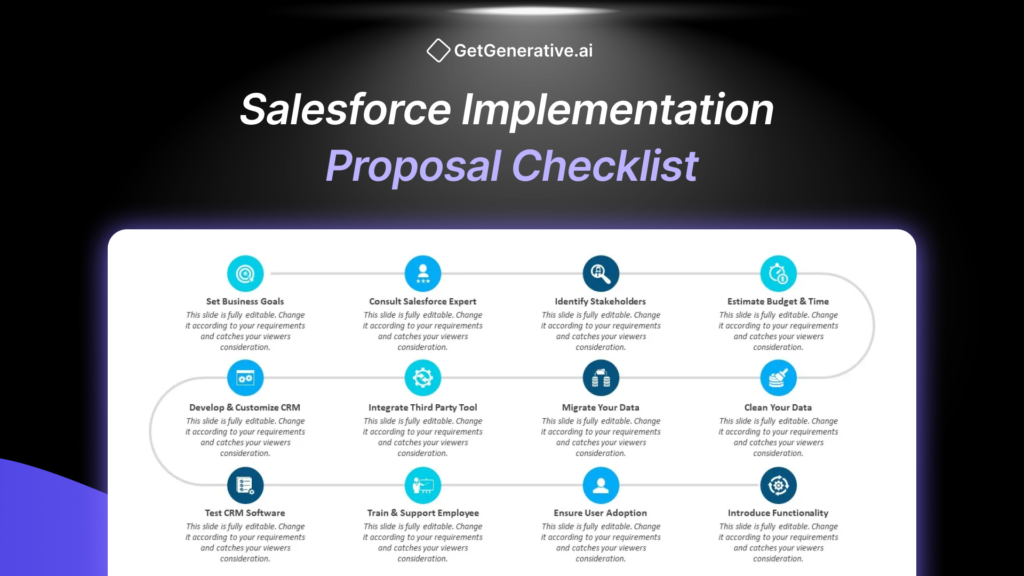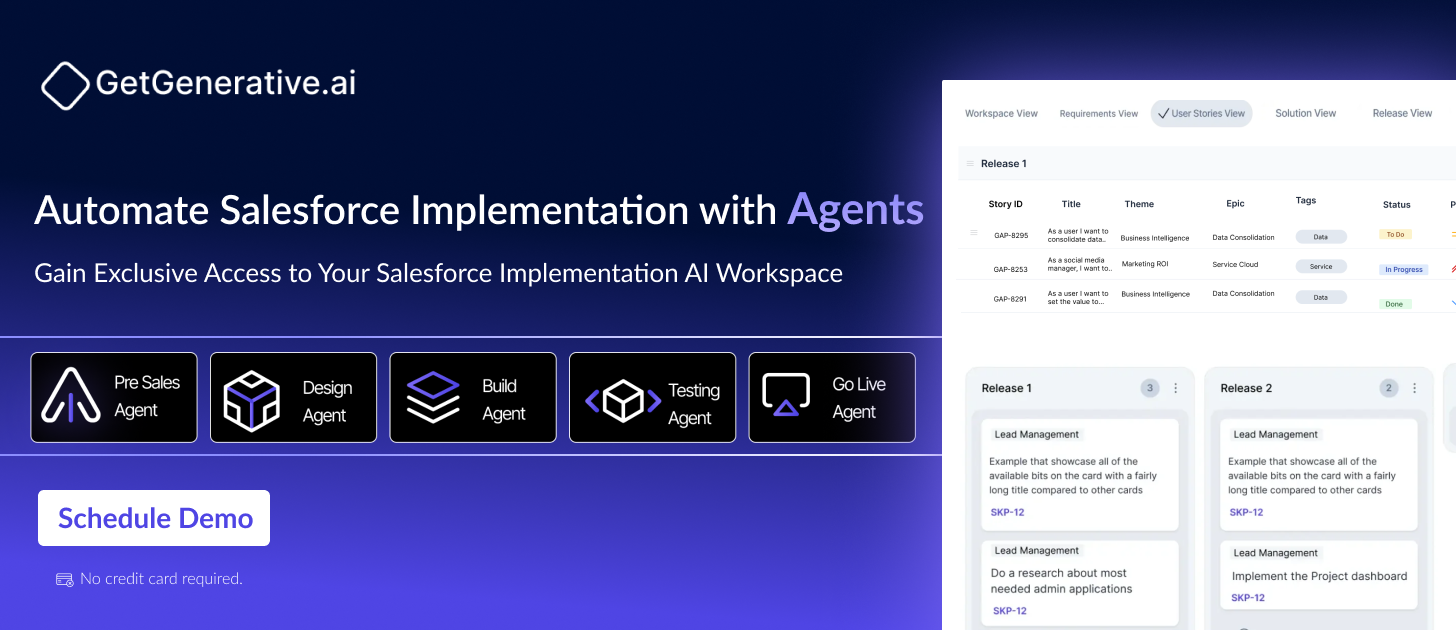Salesforce Implementation Proposal Checklist
In 2025, Salesforce continues to lead the CRM market, serving over 150,000 customers globally. Implementing Salesforce requires careful planning and a structured proposal to ensure your business or client maximizes the system’s potential.
In this blog, we will walk through a detailed Salesforce Implementation Proposal Checklist, designed to guide you through the essential steps of drafting a proposal that sets your implementation project up for success.
Whether you’re using an implementation partner or going solo, this checklist will help you craft a proposal that addresses all key aspects of the implementation process. Let’s get started!
1. Striking Cover Page
The first impression counts, and your Salesforce implementation proposal is no different. The cover page is the first thing your client will see, so it must be visually appealing and set the right tone for the entire document.
Key Features:
- Company branding
- Client-specific details (name, project title, etc.)
- A powerful tagline or project summary that entices interest
Ensure the cover page isn’t just informative but eye-catching, making the client excited to dive into the details of your proposal.
Related Read – Salesforce Proposal Creation with AI Agents
2. Highlight Pain Points
In this section, you’ll empathize with your client’s challenges and highlight the pain points they currently face. By doing so, you show that you understand their needs and position yourself as the right solution.
Questions to Address:
- What challenges are they facing in their current CRM?
- What inefficiencies are impacting their sales or customer service?
- How will Salesforce address these issues?
This is where your proposal can connect with the client emotionally and make them feel that you truly understand their struggles.
“As AI systems like Salesforce’s can solve problems but need guidance on what to solve, individuals must have the drive and initiative to identify and outline problems.”
- Jayesh Govindarajan, Head of AI Engineering at Salesforce
3. Why You’re the Right Fit
This is your chance to shine and explain why you or your Salesforce implementation partner is the perfect fit for the project. You’ll want to build trust by showcasing your expertise, experience, and the unique qualities that set you apart from other service providers.
What to Include:
- Your track record of successful Salesforce implementations
- Awards, certifications, and client testimonials
- Specialized experience in the client’s industry or with similar-sized organizations
This section should highlight your credibility and reassure the client that you’re the right team for the job.
4. Define the Scope of Services
This section outlines the deliverables, so there’s no ambiguity about what will be provided. The scope of services should be clearly defined, detailing each phase of the Salesforce implementation process.
Key Deliverables to Include:
- Requirement gathering and discovery workshops
- Customization of Salesforce (features, workflows, and user interfaces)
- Data migration and integration with existing systems
- User training and change management support
- Post-implementation support and maintenance
Breaking down the scope into clear, measurable deliverables ensures both you and your client are aligned on expectations.
5. Case Study: Showcasing Past Success
A great way to build confidence with your client is by sharing success stories from previous clients. Case studies help clients visualize the potential outcome of working with you and provide proof of your ability to deliver results.
What to Highlight:
- The client’s problem or challenge
- How Salesforce was implemented to address the problem
- The tangible results (increased sales, improved customer service, etc.)
- Testimonials or quotes from satisfied clients
Including a case study gives your proposal credibility and demonstrates your experience with similar projects.
Also Read – The Ultimate Salesforce Implementation Checklist
6. Your Investment: Pricing and Cost Breakdown
Everyone wants to know what they’re going to pay, and this section is where you’ll lay out the pricing options. Be transparent about your fees, and make sure to offer pricing flexibility if needed.
What to Include:
- A detailed breakdown of costs for each phase of the project (e.g., discovery, customization, training)
- Optional add-ons or additional services (e.g., ongoing support, further customization)
- Clear payment schedules and terms
Presenting this section in an easy-to-read format, like an interactive pricing table, will help your client understand the investment required and move forward confidently.
7. Acceptance and Terms & Conditions (T&C)
The final part of your Salesforce implementation proposal is the acceptance section. This is where the client reviews and approves the terms of the proposal.
What to Include:
- The project’s total cost and payment terms
- Milestone-based payments, if applicable
- Key deliverables and timelines
- Legal terms and conditions (consult a legal expert to ensure accuracy)
This is a crucial section, as it formally sets the terms of the project and provides the client with a way to sign off on the proposal.
“Generative AI will reshape how every team operates. Just like with the adoption of the Internet, generative AI represents a generational opportunity to raise the capabilities, skills, and potential of teams throughout the company.”
- Clara Shih, Head of Business AI at Meta
8. The Salesforce Implementation Timeline
A Salesforce implementation can be a complex process, and a timeline will help your client understand when each phase of the project will be completed.
Key Phases to Include:
- Discovery and requirements gathering
- Design and configuration
- Data migration and integration
- Testing and quality assurance
- Training and user adoption
- Go-live and post-launch support
Including realistic timelines will help set expectations and ensure the project progresses smoothly.
Conclusion
A Salesforce implementation proposal is your roadmap to a successful project. By following this checklist, you can ensure that all aspects of the project are covered— from scope and objectives to training and post-launch support. A well-structured proposal will not only help manage expectations but also set the stage for a smooth and efficient Salesforce implementation that delivers real results.
Create proposals in minutes with GetGenerative.ai‘s AI-powered Agents.
Book your demo today and discover how it can help your organization achieve maximum productivity in proposal creation and throughout the entire Salesforce implementation process.
FAQs
1. Why is a Salesforce Implementation Proposal important?
A Salesforce Implementation Proposal serves as a detailed plan for executing a successful Salesforce project, aligning all stakeholders and ensuring that expectations are clearly defined.
2. What should be included in the scope of services?
The scope of services should include all deliverables such as customization, data migration, training, integration, and post-launch support.
3. How long does a typical Salesforce implementation take?
The timeline varies depending on the size and complexity of the project, but most Salesforce implementations take between 3 to 6 months to complete.
4. What is change management in Salesforce implementation?
Change management is a strategy to help employees adapt to Salesforce by providing communication, training, and support throughout the implementation process.
5. How do I ensure the success of a Salesforce implementation?
To ensure success, focus on thorough planning, clear communication, quality data management, and continuous support post-implementation.




